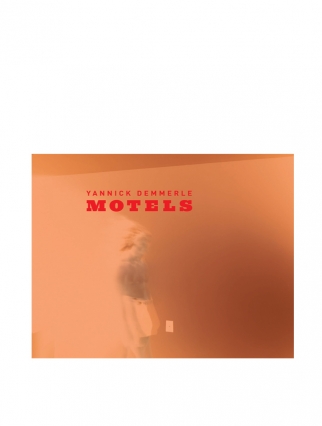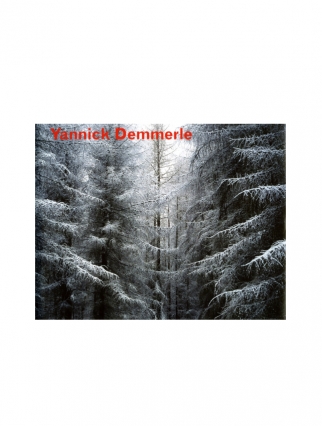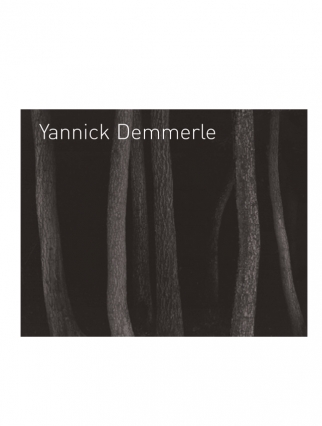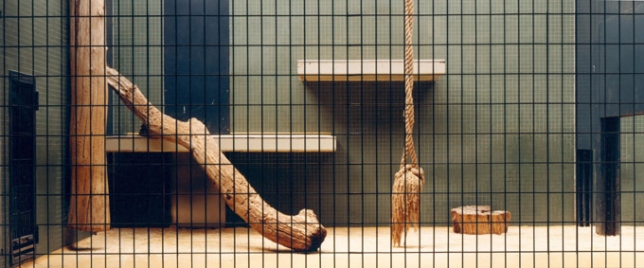20.11.2009 – 31.01.2010
Yannick Demmerle
L’ours, la mort, et les arbres foudroyés
Solo exhibition at Arndt & Partner, Berlin
Yannick Demmerle
Born 1969 in Sarreguemines, France
Lives and works in Tasmania
Yannick Demmerle’s oeuvre traces a remarkably consistent line over the years – from the austere, geometric and symmetric compositions of his early photographs of forests and animal cages to unearthly night shots of woods and surreal negative-colour images of motel rooms, and, finally, to his recent drawings depicting grotesque hybrids of humans and animals and of decomposing and living creatures. While Demmerle’s early images subtly hint at his interest in the fantastic, irrational and dark, these aspects increasingly come to the fore in his later work.
Demmerle creates his images using an 8x10-inch large-format camera, which provides the greatest possible sharpness and depth of focus. He thus attains a maximum degree of realism in his early photographs, such as Sans Titre (2002) and Sans Titre (Gewitter im Wald) (2004), both taken in the Schorfheide nature reserve near Berlin. Yet Demmerle is not interested in documenting reality – nor is he aiming to create a dreamy idyll. As Peter Herbstreuth has remarked, Demmerle doesn’t depict nature as untamed and wild, but as domesticated and governed by the principles of geometry and symmetry. „[There is] no distance, vastness, paths, or any signs of culture, and seldom a horizon. Instead, what rules is regularity, symmetry, rhythmic echelons, rows, or golden sections – the harmony of classical image architecture.“ Thus Demmerle subtly alludes to how our subjugation of nature has shaped the face of the Schorfheide region – a wooded area that was deforested and reforested repeatedly over the centuries and that has only been protected as a nature reserve since 1990.
Similarly, for all their beauty, there is always something unsettling about Demmerle’s landscapes – a sense of disquiet that is conveyed not so much by the tress themselves as by the spaces between them. In Les Nuits Étranges, a series of photographs of nocturnal forests from the year 2004, this sense of unease is even more acute. Eerily illuminated by an invisible light source, individual tree trunks emerge from the black depths like pale, silvery ghosts. The darkness of this menacing forest attains a fantastic, almost “uncanny” quality, alluding to the forest as a metaphor for our repressed subconscious, as it frequently appears in fairy tales, for example.
Yannick Demmerle, studied at the École Supérieure des Arts Décoratifs, Strasbourg. After having resided in Germany for a few years, he now lives and works in Tasmania.
EXHITIONS:
20.11.2009 – 31.01.2010
Yannick Demmerle
L’ours, la mort, et les arbres foudroyés
Solo exhibition at Arndt & Partner, Berlin
25.08. – 01.10.2005
Yannick Demmerle
Solo exhibition at Arndt & Partner, Zurich
26.04. - 31.05.2003
Yannick Demmerle
„Photographs“
Solo exhibition at Arndt & Partner, Berlin
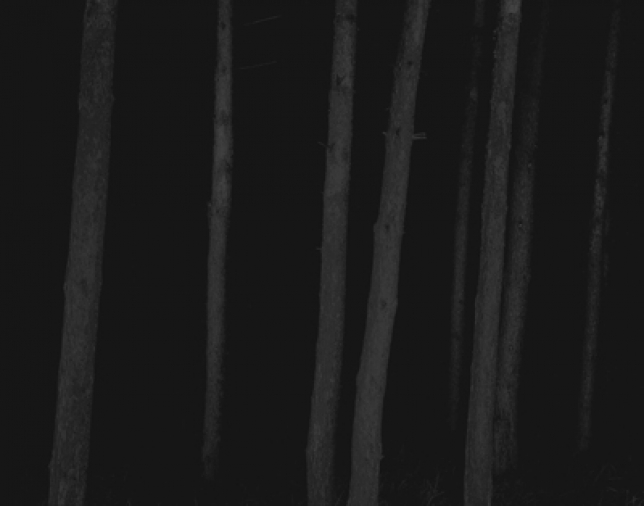 Yannick Demmerle, Untitled #4, from the series "Les Nuits Etranges", 2004, c-print, diasec on aluminiumwooden black frame, waxed, 188 x 233 cm | 74.02 x 91.73 in
Yannick Demmerle, Untitled #4, from the series "Les Nuits Etranges", 2004, c-print, diasec on aluminiumwooden black frame, waxed, 188 x 233 cm | 74.02 x 91.73 in Publication: Yannick Demmerle "Motels", 2007
Publication: Yannick Demmerle, 2003
Publication: Yannick Demmerle, 2005
Exhibitions
Press Release
Yannick Demmerle has made a name for himself with his entrancing, large-scale photographs of forests, lakes and wild-animal cages. His third solo exhibition with Arndt & Partner includes a selection of photographs from the last seven years and a series of recent pencil drawings. The show is tailored to reveal the experimental diversity of photographic techniques Demmerle uses to present his subjects. At the same time, it traces the remarkably consistent lines along which his oeuvre has developed – from the austere, geometric and symmetric compositions of his early photographs of forests and animal cages to unearthly night shots of woods and surreal negative-colour images of motel rooms, and, finally, to his recent drawings depicting grotesque hybrids of humans and animals and of decomposing and living creatures. While Demmerle’s early images subtly hint at his interest in the fantastic, irrational and dark, these aspects increasingly come to the fore in his later work.
Demmerle creates his images using an 8x10-inch large-format camera, which provides the greatest possible sharpness and depth of focus. He thus attains a maximum degree of realism in his early photographs, such as Sans Titre (2002) and Sans Titre (Gewitter im Wald) (2004), both taken in the Schorfheide nature reserve near Berlin. Yet Demmerle is not interested in documenting reality – nor is he aiming to create a dreamy idyll. As Peter Herbstreuth has remarked, Demmerle doesn’t depict nature as untamed and wild, but as domesticated and governed by the principles of geometry and symmetry. „[There is] no distance, vastness, paths, or any signs of culture, and seldom a horizon. Instead, what rules is regularity, symmetry, rhythmic echelons, rows, or golden sections – the harmony of classical image architecture.“ Thus Demmerle subtly alludes to how our subjugation of nature has shaped the face of the Schorfheide region – a wooded area that was deforested and reforested repeatedly over the centuries and that has only been protected as a nature reserve since 1990.
Demmerle applied the same visual principles to his photographs of predator cages taken in zoos in Berlin and Dresden between 2000 and 2003. The neutral, frontal perspective, the strict composition and the sharp contours intensify the cramped, confined, controlled nature of the spaces to the point that they seem to close in on the viewer, creating an oppressive sense of being trapped – despite, or perhaps precisely because of the fact that the wild animals these dismal cages were built to house are absent.
Similarly, for all their beauty, there is always something unsettling about Demmerle’s landscapes – a sense of disquiet that is conveyed not so much by the tress themselves as by the spaces between them. „I spend my time trying to photograph the invisible between the trees, for example fear ... The tree itself does not interest me.“ says Demmerle. In Les Nuits Étranges, a series of photographs of nocturnal forests from the year 2004, this sense of unease is even more acute. Eerily illuminated by an invisible light source, individual tree trunks emerge from the black depths like pale, silvery ghosts. The darkness of this menacing forest attains a fantastic, almost “uncanny” quality, alluding to the forest as a metaphor for our repressed subconscious, as it frequently appears in fairy tales, for example.
While most of Europe’s forests are today no longer menacing in a life-threatening sense, the millenniums-old forests of Tasmania harbour countless deadly hazards and dangers. And yet Demmerle has repeatedly risked life and limb by hiking through the wilds for weeks on end, accompanied only by his bulky camera equipment. The photographs he creates in the solitude of this remote wilderness reveal nature at its most frightening, much as German landscape painting in the Romantic era did. But while the Romantic painters always included an element of civilisation in their pictures – a ruin, a path, a human being – and depicted their motif from a distance and with a visible horizon, Demmerle closes in on his subjects to the point that no escape is possible. There is no horizon and no living creatures to be seen in these images, which reveal a wilderness that is merciless, alien and menacing in its sheer unbridled force.
In the pencil drawings Demmerle produced in Tasmania in 2009, we encounter the forest creatures and inhabitants that are so conspicuously absent in the photographs. Demmerle’s view of the reality of the forest is manifested much more subjectively here. His fantastic, at times monstrous hybrids of humans, animals and insects, of animal cadavers and plants represent Demmerle’s attempt to appropriate the never-ending cycle of nature, in which decaying matter gives birth to new life. At the same time, the drawings convey an impression of the artist’s desire to break out of the rigid restraints imposed by life in the wilderness and to escape into a realm where he is free to play with manifestations of the surreal and the irrational.
Text: Kristin Rieber
Yannick Demmerle, born in 1969 in Sarreguemines, France, studied at the École Supérieure des Arts Décoratifs, Strasbourg. After having resided in Germany for a few years, he now lives and works in Tasmania.
Demmerle had been included to several group exhibitions such as the ICP Triennial of Photography and Video at the International Center of Photography, New York and the 2. Internationalen Fotofestival in Mannheim, Ludwigshafen and Heidelberg. In 2005 the Leonhardi Museum in Dresden, the Sint-Lukasgalerie in Brussels and the Kunstverein Lingen, Germany dedicated him a solo show.
25.08. – 01.10.2005
Yannick Demmerle
Solo exhibition at Arndt & Partner, Zurich
26.04. - 31.05.2003
Yannick Demmerle (F)
„Photographs“
Solo exhibition at Arndt & Partner, Berlin
PRESS RELEASE
Yannick Demmerle's photographs are of overwhelming beauty. His recent oeuvre encompasses landscapes and forest motives, as well as, in a second body of work, empty animal cages shot in zoos. The immediate attraction of his photographs lies in the extreme nearness and density of his motives, which deny the viewer a secure distance. Larger parts of sky or even the horizon can rarely be seen. The beholder's view meets the narrowly standing trunks or gets trapped in the undergrowth, unable - or unwilling - to free himself.
Demmerle's art neither shows us an idyllic view of nature, nor an analysis in realism. This nature is haunted by the Uncanny - a mystery that should have remained concealed, but that nevertheless touches us. It is the return of the once familiar, made strange and frightening by repression, and now blurring the distinction between the real and the imagined. In this, Demmerle's pictures can also be seen as metaphors for the medium of photography in itself: Photography's omnipresence and its generally accepted strength in representing reality, have repressed the uncanniness, latently inhabiting this medium, e.g. the doubling, and the seeming presence of the non-present. These peculiarities have been faded out from our conscience as something all too familiar.
It is no coincidence that the French photographer has been working in the greater area of Berlin for three years now. He sees himself in the tradition of northern romanticists such as Friedrich, Runge, and Carus. However, with Demmerle, the romantic painter's intimate commune with nature turns into a supernatural anxiety. An impression of emptiness and silence seems to gain ground: the feeling of being tragically locked in. Nature is a companion which is inhabited poorly by man.
The stringency and authenticity of this young artist's oeuvre is also evident in his series of cages photographed in the zoos of Berlin and Dresden. There are always cages of wild animals, but these are constantly absent, leaving behind empty cages. It seems as if he would want to free the tamed wild in a symbolic gesture, or at least pay his respect by not showing the animals in their cages. At the same time, the feeling of being locked-in reaches an evermore oppressing quality through the absence of the caged subject.
Yannick Demmerle was born in 1969 in Sarreguemines, France, and did his studies at the Ecole Supérieure des Arts Décoratifs, Strasburg. After exhibitions, amongs others, in Paris, Groningen and Strasburg, Arndt & Partner are delighted to present the artist's first solo exhibition in Germany. In 2003, Yannick Demmerle will furthermore be given solo shows at Vedanta Gallery, Chicago, at the Château d'Oiron, France, as well as at the FRAC Alsace, Sélestat. Demmerle lives and works in Eberswalde near Berlin.
